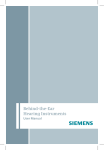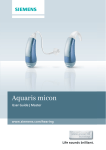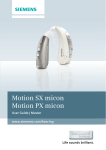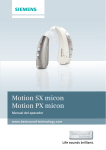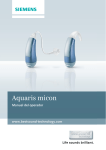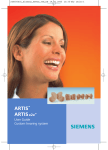Download Siemens CENTRA Instruction manual
Transcript
CENTRA ® Instruction Manual for CENTRA S, S VC, and Life Behind-the-Ear Hearing Instruments ® Siemens Hearing Instruments Your CENTRA® Hearing Instruments Siemens CENTRA® BTE (Behind-the-Ear) hearing instruments are designed for comfort, performance, and durability. They fit comfortably behind your ears and are attached to custommade earmolds or flexible LifeTubes and LifeTips. Your CENTRA BTE will look similar to one of the following illustrations (Fig. 1). Microphones Earhook Memory button Programming socket* Audio input flap Battery compartment door CENTRA S CENTRA S, S VC, and Life BTEs 1 Microphones Earhook Volume control wheel Programming socket* Battery compartment door Audio input flap CENTRA S VC Microphones S-LifeTube Memory button Programming socket* Audio input flap LifeTip adapter Battery compartment door LifeTip CENTRA S/S VC with S-LifeTube Centra S and S VC available with S-LifeTube 2 Siemens Hearing Instruments Microphone ports LifeTube Programming socket* Battery compartment door LifeTip LifeTip Adapter CENTRA Life Fig. 1: Location of features *Audiologist or Hearing Care Provider’s Use Only CENTRA S, S VC, and Life BTEs 3 Identifying the left and right hearing instruments CENTRA BTEs may be color-coded for your convenience. The left ear hearing instrument may have a blue typeplate, and the right ear hearing instrument may have a red typeplate (Fig. 2). Typeplate Fig. 2: Location of typeplate on CENTRA S/CENTRA S VC In addition, on CENTRA Life BTEs, the left ear hearing instrument has a blue number on the LifeTip Adapter, and the right ear hearing instrument has a red number on the LifeTip Adapter (Fig. 3). 4 Siemens Hearing Instruments Color-coded number on Tip Adapter Fig. 3: Location of right and left designator on LifeTip Adapter on CENTRA Life Digital hearing instrument technology Inside your hearing system, the microphone, analog-to-digital converter, digital signal processor, receiver, and other specialized components process sound that is directed to the eardrum and auditory system. The microphone picks up sound waves from the air and converts them to electrical signals. The analog-to-digital converter encodes the electrical signals into a format that is usable by the digital signal processor, which has been programmed by your Audiologist or Hearing Care Provider for your particular hearing loss. The receiver converts the digitally processed signal directly back into sound waves. CENTRA S, S VC, and Life BTEs 5 Using your CENTRA hearing instruments Battery size The chart below provides the proper battery size used in your hearing instruments. It is recommended that you also check with your Audiologist or Hearing Care Provider regarding the correct battery. Model CENTRA S Behind-the-Ear Size 13 CENTRA S VC Behind-the-Ear 13 CENTRA Life Behind the Ear 312 Inserting the battery To insert the battery into the hearing instrument, use your fingernail to swivel open the door of the battery compartment. Place the proper size battery (see "Battery" section or consult your Audiologist or Hearing Care Provider) in the battery compartment so that the "+" symbol on the battery coincides with the "+" mark on the battery compartment door. 6 Siemens Hearing Instruments Gently close the battery compartment. Do not force the door shut. If it does not close easily, check to see if the battery was inserted properly. When the battery door is completely closed, your hearing instrument is ready for operation (Fig. 4). Battery + Opened battery compartment door CENTRA S/CENTRA S VC CENTRA Life Fig. 4: Inserting the battery CENTRA S, S VC, and Life BTEs 7 Battery compartment door lock CENTRA S and CENTRA S VC hearing instruments are equipped with a lock that prevents the unintentional opening of the battery compartment. This feature is located on the inner side of the battery compartment door. To lock the battery compartment, open the compartment door to the first catch. Push the slide toward the right. To unlock the battery compartment for opening, open the door to the first catch and push the slide to the left (Fig. 5). Your Audiologist or Hearing Care Provider can instruct you on the use of this feature, if required. Remember, the battery should be removed when your hearing instruments are not in use. This prevents possible damage from battery leakage and avoids draining the batteries if the hearing instruments are not switched off. 8 Siemens Hearing Instruments Fig. 5: Battery compartment door lock Low battery indicator Your hearing instrument may be programmed to inform you when the battery should be replaced for best performance. If this is activated in your hearing instruments, you may hear two long, low-pitched beeps and/or experience low amplification power or volume. Change the battery immediately when either of these occur. WARNING: Choking hazard posed by small parts. • Keep hearing instruments, batteries, and accessories out of children’s reach. • If swallowed, consult a physician or a hospital immediately. CENTRA S, S VC, and Life BTEs 9 • If infants, small children, or mentally disabled persons need to wear hearing instruments, ensure adequate supervision. Battery tips CAUTION! Batteries can be harmful if swallowed. • If a battery is accidentally swallowed, seek medical attention immediately, or call The National Button Battery Hotline collect at (202) 625-3333. • Always use the battery size recommended on your warranty card, or by your Audiologist or Hearing Care Provider, for your model for best performance. • Remove the battery from your instrument when not in use. This prevents possible damage from expansion or leakage of the battery, if the instrument is not fully turned off. • Always carry spare batteries in the event that your current battery goes dead. Place each spare battery in an individual, nonmetallic container to prevent contact with other batteries or metal objects, such as keys or coins. 10 Siemens Hearing Instruments • Follow your localrecyclingrules for battery disposal. Note: Do not throw used batteries into household trash. Return them to your Audiologist or Hearing Care Provider for environmentally correct disposal. WARNING: Risk in explosive environments, e.g., mining areas! • Don’t use your hearing instruments (and remote control) in areas where there is a danger of explosions. Turning the hearing instrument on or off Using the battery door, insert a battery into the instrument and completely close the door to turn the instrument on. To turn the aid off using the battery door, open it to the first catch. CENTRA S hearing instruments may also be programmed to allow you to turn them on and off using the memory button. To turn the instrument off using the memory button, press and hold the button for 3 – 5 seconds. To turn it back on, press and hold the memory button for 3 – 5 seconds. CENTRA S, S VC, and Life BTEs 11 Please note that after having turned the hearing instrument off using the memory button, you must wait approximately 10 seconds for the system to reset before turning it back on again by using the memory button. Check with your Audiologist or Hearing Care Provider about which on/off functions are available on your hearing instrument. Power-on delay Your hearing instruments may be equipped with an advanced power-on delay feature. This feature delays sound from entering your hearing instruments when they are first turned on, so that you may insert the instruments into your ears without experiencing unpleasant feedback (whistling). 12 Siemens Hearing Instruments Attaching the earmold (where provided) If your earmold detaches, gently insert the earhook of the hearing instrument into the tubing and earmold supplied by your Audiologist or Hearing Care Provider (Fig. 6). Fig. 6: Attaching the earmold Inserting and removing hearing instruments with earmold Take the earmold between your thumb and index finger. Gently work the earmold into its proper position by adjusting it until it is firmly seated in your ear. Then lift the hearing instrument over the top of your ear and adjust it to fit behind your ear (Fig. 7). CENTRA S, S VC, and Life BTEs 13 Fig. 7: Inserting the hearing instrument Lightly push on the back of the ear to help release the earmold and gently pull it out (Fig. 8). Fig. 8: Removing the hearing instrument 14 Siemens Hearing Instruments Inserting and removing hearing instruments with LifeTube or S-LifeTube Take the LifeTip between your thumb and index finger. Gently work the LifeTip into its proper position by adjusting it until it is firmly seated in your ear. Then lift the hearing instrument over the top of your ear and adjust it to fit behind your ear (Fig. 9). Finally, place the retention strand into the bottom of the ''bowl'' of your ear. Fig. 9: Inserting the hearing instrument To remove the instrument, gently pull the LifeTip out of your ear and carefully lift the hearing instrument off your ear (Fig. 10). Do not pull or tug on the LifeTube to remove the Tip or instrument, or the LifeTube may become damaged. CENTRA S, S VC, and Life BTEs 15 Fig. 10: Removing the hearing instrument Health considerations If soreness or skin irritation develops, discontinue wearing your hearing instrument and bring the instrument and earmold to your Audiologist or Hearing Care Provider. Minor fit adjustments or earmold modification can often correct this condition. If soreness persists, discontinue wearing the hearing instrument and see your physician. If excessive ear wax accumulates when wearing your hearing instruments, consult your Audiologist or Hearing Care Provider. 16 Siemens Hearing Instruments e2e wireless® e2e wireless® provides synchronization in CENTRA hearing instruments. If you are wearing two hearing instruments and change the memory or volume on one instrument, the other is automatically changed. In addition, e2e wireless technology automatically adjusts the system to change both hearing instruments simultaneously to adapt to different listening situations. The wireless functionality also enables use of an optional ePocket® remote control. Your Audiologist or Hearing Care Provider can provide more information on the wireless functionality of your CENTRA hearing system. Note: The performance of the e2e wireless could be temporarily affected when in close proximity to electromagnetic noise sources, such as a computer monitor or television. Move away from the noise source if you experience difficulty. CENTRA S, S VC, and Life BTEs 17 ePocket remote control An optional ePocket remote control is available for all CENTRA hearing systems. ePocket can be used to change the memory and volume of your hearing instrument, as well as read out the system settings without having to manually adjust the hearing instruments. For further information on the ePocket, speak to your Audiologist or Hearing Care Provider, or refer to the ePocket instruction manual, if applicable. Changing the memory CENTRA BTEs may have up to four memories, also called hearing programs. Each memory is different and designed to help you hear better in specific listening situations. On CENTRA S BTEs, three of the four memories are selected with the memory button of your hearing instrument. The fourth memory is activated automatically when an audio shoe is attached to the hearing instrument (see "Audio Input" section). 18 Siemens Hearing Instruments Additional memories are available on CENTRA S VC and CENTRA Life BTEs, if you use an optional ePocket remote control. When initially turned on (after the battery compartment door is closed), the microphone is ON and ready for general use, the default is Memory 1. Your Audiologist or Hearing Care Provider will provide you with the number of memories most appropriate for your needs. Each time you press the memory button on the instrument or press the "P" button on the ePocket, the instrument changes to the next memory. The memory change may be confirmed by alerting tones or beeps that correlate to the memory you are in. That means if you select Memory 3, then the hearing instrument beeps three times. If you are wearing two CENTRA hearing instruments, your Audiologist or Hearing Care Provider can program them so that the memory will be changed on both instruments at the same time when you press the memory button. CENTRA S, S VC, and Life BTEs 19 Below is a list of listening environments programmed into your hearing system: Memory number Listening environment 1 _________________________________ 2 _________________________________ 3 _________________________________ 4 Audio Input (CENTRA S and CENTRA S VC only) Using the directional microphone system According to your hearing needs, your CENTRA BTE hearing systems can be adjusted to focus on sounds in front of you (directional mode), for when you are having a face-to-face conversation in a noisy environment. The hearing system can also be adjusted for when you are in more quiet environments and want to hear the sounds around you (omnidirectional). 20 Siemens Hearing Instruments Your Audiologist or Hearing Care Provider may program the operation of the directional microphone system to function automatically, or in conjunction with the memory button (or ePocket where applicable), based on your particular hearing requirements. Consult your Audiologist or Hearing Care Provider for more information on use of the directional microphone system based on the settings of your specific hearing system. Volume Control Your CENTRA hearing instrument is fully automatic. There is no need to manually adjust the volume control. However, if you prefer manual control, your CENTRA S VC BTEs can be programmed for manual adjustments with a volume control wheel and/or the ePocket. Volume on the CENTRA S and CENTRA Life BTEs can only be programmed for adjustment using the ePocket. If your system is programmed for manual adjustment, the wheel-shaped volume control on the BTE can be rotated up or down, or the CENTRA S, S VC, and Life BTEs 21 volume up (+) and down (-) buttons on the ePocket can be used to select the most desired listening position (louder or softer). To increase the volume, place your index finger gently against the volume control wheel and rotate it upwards or use the volume up button on the ePocket. To reduce the volume, rotate the wheel in the opposite direction or use the volume down button on the ePocket. Once the maximum or minimum volume has been reached, further changes to the volume in that direction will have no effect. If you are wearing two hearing instruments, your Audiologist or Hearing Care Provider can couple the controls, so that the volume of both will change at the same time when you adjust either the volume control wheel or the ePocket. You may hear soft beeps each time you change the volume, then a three-beep warning when the volume limit has been reached. These tones can be enabled or disabled by your Audiologist or Hearing Care Provider. 22 Siemens Hearing Instruments If your hearing instrument has not been programmed for manual control adjustment, the volume will adjust automatically and rotating the volume control wheel or using the volume control buttons on your ePocket will have no effect. Learning volume preference feature (where provided) The learning volume preference feature retains information on when and how you adjust the volume on your CENTRA instruments programmed for manual adjustment. Over time, your CENTRA hearing system will automatically adjust to that preferred volume in each listening program. For more information about this feature, speak with your Audiologist or Hearing Care Provider. CENTRA S, S VC, and Life BTEs 23 Audio Input CENTRA S and CENTRA S VC hearing instruments are equipped with audio input capability. This enables you to connect your hearing instruments to other audio sources such as an FM system, tape recorder, television, or infrared system using an audio shoe accessory. It can be useful for adults in difficult listening situations and for children in classrooms. Because the sound is coming directly from the sound source to the hearing instrument, the signal is clearer and unaffected by poor room acoustics. Attaching and removing the audio shoe 1 2 3 4 5 Fig. 11: Attaching the audio shoe 24 Siemens Hearing Instruments 1. Using the fingernail of your thumb or index finger, open the battery compartment door to the first catch. 2. Using your fingernail, lift up the audio input flap, exposing the gold contacts. 3. Close the battery compartment door. 4. Place the gold contacts of the audio shoe on the gold contacts under the audio input flap on the CENTRA BTE. Gently push the audio shoe into place by pressing the audio shoe toward the underside of the hearing instrument until it snaps into place. 5. To remove the audio shoe, hold the BTE with one hand and the audio shoe with the other hand. Gently pull the audio shoe off, guiding it from the underside towards the gold contacts. Close the audio input flap. Note: When controlling CENTRA BTE instruments with an audio shoe attached to one or both hearing instruments, the memory button on the ePocket or on the instruments will not change programs. It can be programmed to select the audio mode only (audio input only, microphone only, or mixed mode). The volume can be changed using the ePocket. CENTRA S, S VC, and Life BTEs 25 Using the telephone CENTRA S and CENTRA S VC hearing instruments are equipped with a T-coil (telecoil) for telephone use. It may be programmed to work in a specific listening program in conjunction with the memory button. In the T-coil mode, place the telephone receiver close to your hearing instrument for best reception. By trying various positions of the telephone receiver, you will discover what works best for you. Your Audiologist or Hearing Care Provider can advise you on the proper use of the T-coil and all hearing instrument settings. Note: In order for the telecoil to function properly, your telephone must be "hearing aid compatible." Check your telephone’s instruction manual to find out whether your phone has this capability. If you are using an ePocket remote control, be sure to change your listening program out of T-coil mode before using the "Data Read Out" function. Using the "Data Read Out" function while in T-coil mode will cause a loud pulsing noise to be heard, due to pickup of the transmission signal of the T-coil. 26 Siemens Hearing Instruments Automatic telephone feature The AutoPhone® option allows the telecoil in CENTRA S and CENTRA S VC instruments to automatically engage when a "hearing aid compatible" telephone handset is brought close to the hearing instrument. To operate, bring the telephone handset close to the hearing instrument. The telecoil will automatically engage to the presence of the electromagnetic signal from the telephone. When you are finished speaking on the phone, move the handset away from the hearing instrument and the microphone mode will reestablish itself. CENTRA S, S VC, and Life BTEs 27 Cell Phone Compatibility Some hearing instrument users have reported a buzzing sound in their hearing instruments when they are using cell phones, indicating that the cell phone and hearing instruments may not be compatible. According to the ANSI C63.19 standard (ANSI C63.19-2006 American National Standard Methods of Measurement of Compatibility Between Wireless Communications Devices and Hearing Aids), the compatibility of a particular hearing instrument and cell phone can be predicted by adding the rating for the hearing instrument immunity to the rating for the cell phone emissions. For example, the sum of a hearing instrument rating of 2 (M2/T2) and a telephone rating of 3 (M3/T3) would result in a combined rating of 5. Any combined rating that equals at least 5 would provide “normal use”; a combined rating of 6 or greater would indicate “excellent performance.” 28 Siemens Hearing Instruments The immunity of this hearing instrument is at least M2/T2. The equipment performance measurements, categories, and system classifications are based upon the best information available but cannot guarantee that all users will be satisfied. NOTE: The performance of individual hearing instruments may vary with individual cell phones. Therefore, please try this hearing instrument with your cell phone or, if you are purchasing a new phone, be sure to try it with your hearing instrument prior to purchase. For additional guidance, please ask your cell phone provider for the booklet entitled "Hearing Aid Compatibility with Digital Wireless Cell Phones." CENTRA S, S VC, and Life BTEs 29 AutoPhone magnet accessory There is an AutoPhone magnet accessory available for your telephone that can be used with the AutoPhone feature of your hearing system. Ask your Audiologist or Hearing Care Provider about this accessory and if it is appropriate for your individual hearing care needs. Note: When magnets are properly cared for, they are safe to use and can last a lifetime. However, the following guidelines should be followed while using these magnets. Magnets can pose risks to electronics and magnetic storage media when placed in close proximity. Be careful not to place magnets near computers, color monitors, television sets, floppy disks, video/audio tape, and other electronic equipment. Magnets may interfere with the operation of life support systems, such as pacemakers, magnetic valves, etc. Make certain to maintain a distance of at least four inches between the magnet and the area of your support system. Keep magnets out of the reach of children and pets. If accidentally swallowed, seek medical attention. 30 Siemens Hearing Instruments Identification Information Your hearing instruments have a serial number engraved on them. The location of the serial number will vary according to the style of hearing instrument you have chosen. The year of manufacture is incorporated into the serial number. Please note the warranty is based upon the date of purchase, not the date of manufacture. The serial number may look similar to this sample: AS12345. The second letter of this serial number refers to the year of manufacture of the hearing instrument. The letters S or T indicate the year of manufacture of your BTE as 2008. Your Audiologist or Hearing Care Provider can answer any questions you may have about the identifying code on your hearing instrument. Record the serial numbers of each instrument in the space provided for future reference. Serial numbers: Left ear:____________________________________ Right ear: __________________________________ CENTRA S, S VC, and Life BTEs 31 + - AS12345 Serial number Fig. 12: Identification information Maintenance and care Consult your Audiologist or Hearing Care Provider about appropriate cleaning and maintenance for your particular type of earmolds or your LifeTube and LifeTip. Always store your hearing instruments inside the case. A soft carrying pouch is also included for your convenience when traveling. Never immerse your hearing instruments in water! If needed, your CENTRA BTEs can be wiped with a tissue or other clean, dry cloth. Do not use water, alcohol, benzene, or any other liquid household cleaning agent to clean your instruments, as it may damage them. IC: 267AB-WL001 This device complies with Part 15 of the FCC Rules. Operation is subject to the following two conditions: (1) this device may not cause harmful interference, and (2) this device must accept any interference received, including interference that may cause undesired operation. Changes or modifications not expressly approved by the party responsible for compliance could void the user's authority to operate the equipment 32 Siemens Hearing Instruments Your Audiologist or Hearing Care Provider: Siemens Hearing Instruments, Inc. P.O. Box 1397 Piscataway, NJ 08855-1397 www.usa.siemens.com/hearing Information in this manual subject to change without notice. Copyright © 2009 Siemens Hearing Instruments, Inc. All Rights Reserved 10149169 2/09 5.2 22C108 5K SHI/10029-9






































